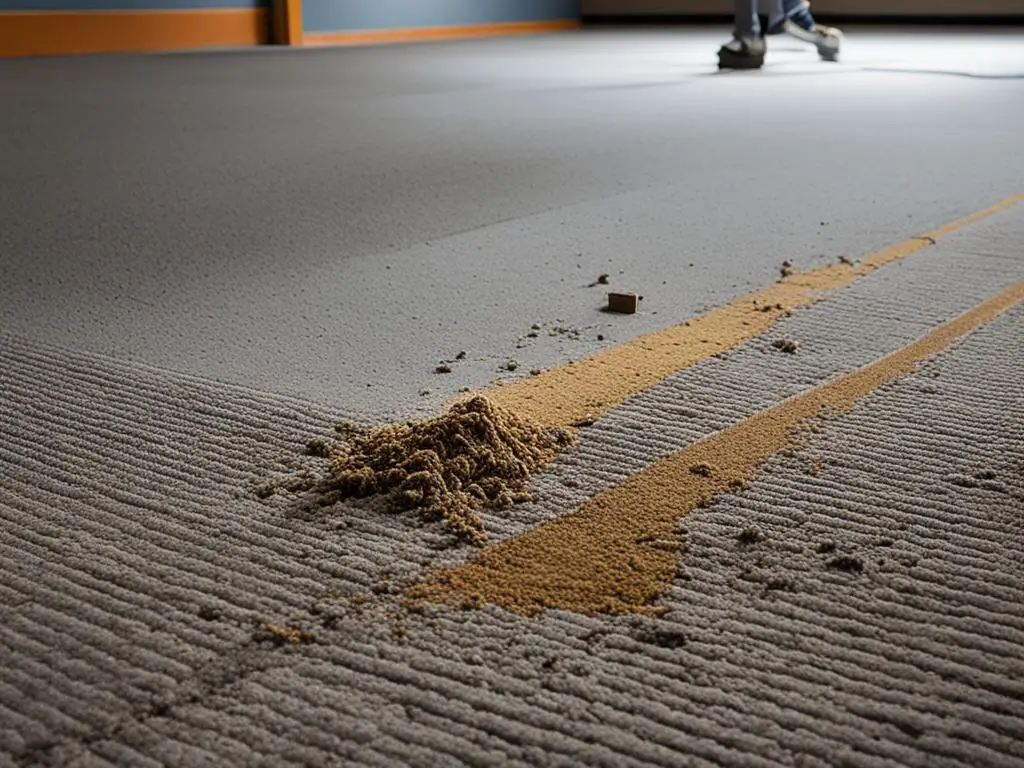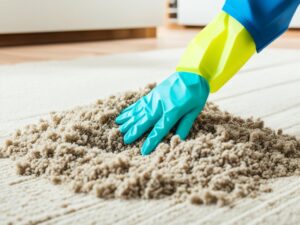When it comes to what is usually under carpet, there are multiple layers that make up the floor. The top layer is the floor covering, which can be hardwood, laminate, vinyl, carpet, or other options. Next is the underlayment, which provides sound dampening and moisture protection, especially for carpets. The subfloor is the layer beneath, providing a structural surface and can be made of plywood, OSB, or concrete. Finally, there are the floor joists, which are the foundation of the floor. These layers work together to ensure the stability and durability of the floor.
Key Takeaways:
- Common under carpet materials include hardwood, laminate, vinyl, and carpet.
- Popular carpet underlayment options provide sound dampening and moisture protection.
- The subfloor, often made of plywood, OSB, or concrete, provides a structural surface.
- Floor joists serve as the foundation of the floor.
- Understanding the layers beneath the carpet helps make informed flooring decisions.
The Floor Covering
The floor covering is the top layer that you walk on and see. It can be vinyl, ceramic, laminate, hardwood, or other materials depending on personal preferences, budget, and design. Each type of floor covering has its own unique characteristics and benefits.
Vinyl Flooring
Vinyl flooring is a popular choice due to its durability and affordability. It is resistant to moisture, making it suitable for high-traffic areas such as kitchens and bathrooms. Vinyl flooring comes in various styles and patterns, including designs that mimic the look of hardwood or ceramic tiles.
Ceramic Flooring
Ceramic flooring is known for its elegance and versatility. It is made from natural materials and is available in different shapes, sizes, and colors. Ceramic tiles are highly resilient and resistant to stains, making them ideal for areas prone to spills and high humidity.
Laminate Flooring
Laminate flooring offers the look of hardwood at a more affordable price. It is constructed with a high-density fiberboard core and a photographic layer that replicates the appearance of natural wood. Laminate flooring is easy to clean and maintain, making it suitable for busy households.
Hardwood Flooring
Hardwood flooring is a timeless option that adds warmth and elegance to any space. It is available in a variety of wood species, each with its unique grain patterns and colors. Hardwood floors can be sanded and refinished multiple times, making them a durable and long-lasting choice.
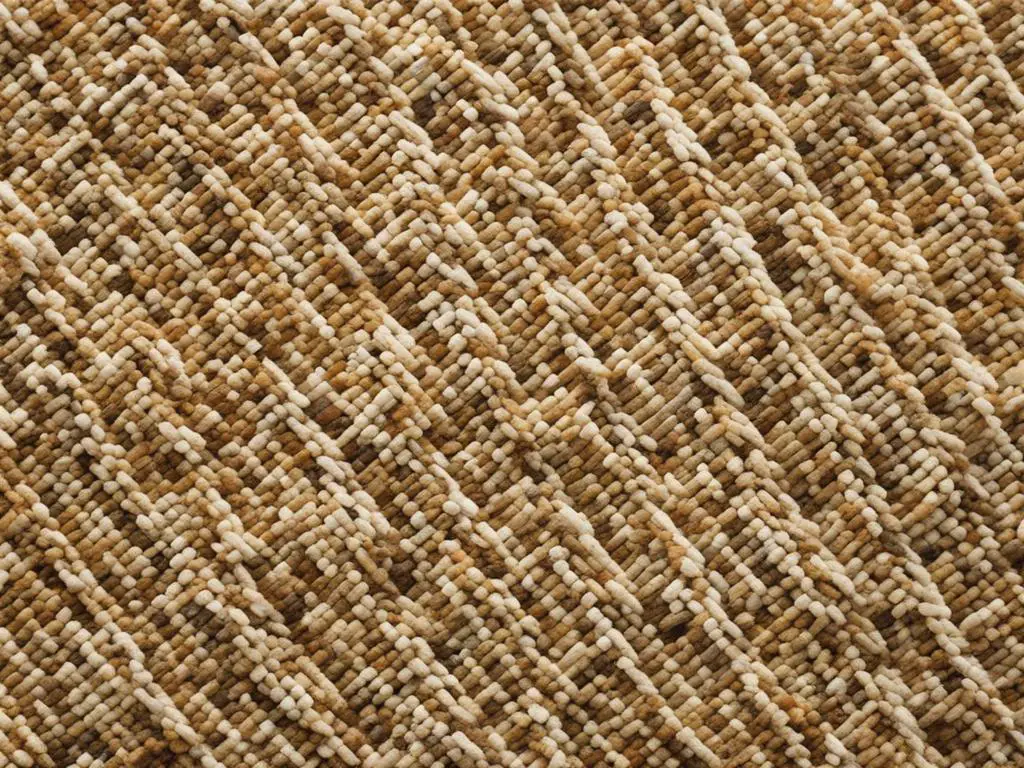
The Underlayment
The underlayment is an essential layer that sits between the floor covering and the subfloor. Its primary purpose is to provide a smooth and flat surface while offering several other key benefits:
- Sound Dampening: Underlayment helps to reduce noise transmission between floors, making it particularly important for areas where noise control is essential, such as living rooms or bedrooms.
- Moisture Protection: It acts as a barrier, preventing moisture from reaching the floor covering, which helps to protect it against potential damage caused by spills, pet accidents, or humidity.
- Added Comfort: Underlayment enhances the overall comfort of the floor by providing a cushioning effect when walking on it, particularly when it comes to carpets.
- Improves Thermal Insulation: Underlayment can also help to enhance the energy efficiency of the floor by providing an additional layer of insulation, making it particularly suitable for colder climates.
Various materials can be used for the underlayment, depending on the specific requirements of the floor covering:
- For carpet flooring, foam or rubber pads are commonly used as underlayment materials. These provide cushioning and enhance the softness and comfort of the carpet underfoot.
- Laminate flooring typically requires an underlayment that acts as both a moisture barrier and a sound barrier. Materials like foam or cork are commonly used.
- Hardwood and ceramic tile floors often have padding glued to the underside of the planks or tiles, creating a built-in cushioning effect.
The choice of underlayment materials depends on factors such as the type of floor covering, the level of comfort desired, the specific needs of the room, and the budget. It’s essential to select the appropriate underlayment to ensure optimal performance and longevity of the floor.
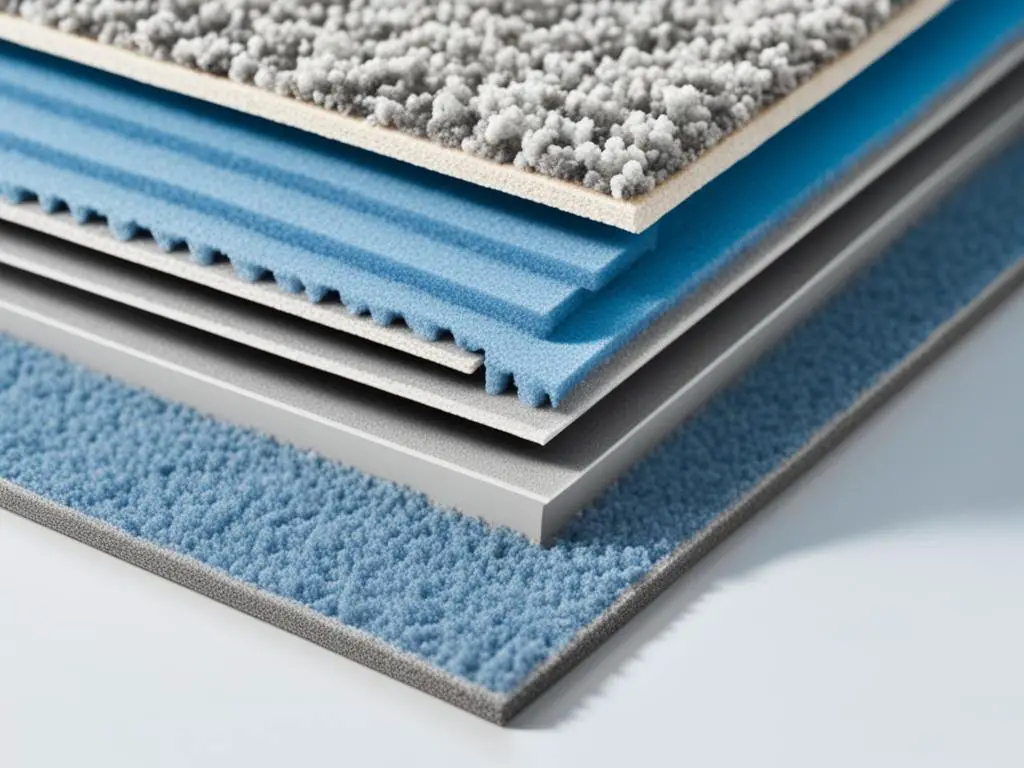
Quote:
“The underlayment plays a crucial role in providing a solid foundation for the floor covering. It not only enhances comfort and reduces noise but also offers protection against moisture. Choosing the right material for the underlayment is essential for ensuring the overall performance and durability of the floor.” – Flooring Expert
The Subfloor
The subfloor is an essential layer that provides structural support and stability to the floor. It is located beneath the underlayment and serves as a foundation for the other layers. Understanding the different materials used for subflooring is crucial in ensuring a durable and long-lasting floor.
Plywood Subfloor
Plywood is one of the most commonly used materials for subflooring. It is made by gluing together layers of thin wood veneers, creating a strong and stable panel. Plywood subfloors are known for their strength and resistance to swelling when exposed to moisture. They are often used in residential and commercial buildings due to their versatility and durability.
OSB (Oriented Strand Board) Subfloor
OSB is another popular choice for subflooring. It is made by compressing and gluing together strands of wood chips. OSB subfloors offer excellent structural strength and stability and are less expensive than plywood. However, they are more prone to swelling when exposed to moisture and require careful installation to prevent moisture-related issues.
Concrete Subfloor
In high-rise buildings and basements, concrete subfloors are commonly used. Concrete offers exceptional durability and strength, making it suitable for heavy-duty applications. However, installing certain types of floor coverings, such as hardwood or laminate, directly on a concrete subfloor may require additional preparation and the use of a floating subfloor to provide cushioning and prevent moisture-related problems.
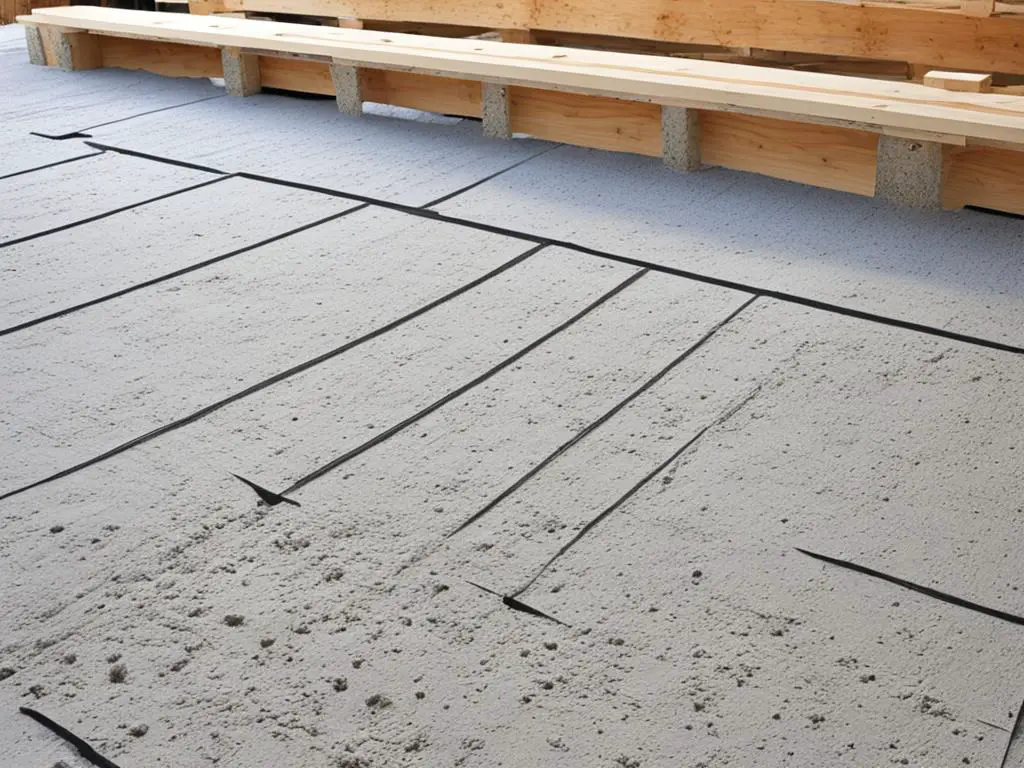
Choosing the right subfloor material depends on various factors, including the type of floor covering and the specific requirements of the space. Here is a comparison of the characteristics of plywood, OSB, and concrete subfloors:
| Subfloor Material | Strength | Moisture Resistance | Cost |
|---|---|---|---|
| Plywood | High | Good | Medium |
| OSB | High | Fair | Low |
| Concrete | Very High | Excellent | High |
As shown in the table, plywood offers high strength and good moisture resistance, making it a reliable choice for most applications. OSB provides high strength at a lower cost, but it is less resistant to moisture. Concrete subfloors excel in strength and moisture resistance, but they require special installation considerations.
Ultimately, the choice of subfloor material depends on factors such as budget, environment, and specific flooring requirements. Consulting with a professional flooring installer can help determine the best subflooring material for your project, ensuring a solid foundation for your floors that will withstand the test of time.
The Floor Joists
Floor joists are an essential component of any building’s structure as they provide the foundation for the floor and support all the layers above. They play a crucial role in ensuring the stability and durability of the floor.
The purpose of floor joists is to distribute the weight of the floor, furniture, and occupants evenly across the underlying support system. They transfer the load to the foundation or bearing walls, preventing sagging or structural failures.
There are two main types of floor joists commonly used: engineered wood joists and dimensional lumber joists.
Engineered Wood Joists
Engineered wood joists consist of multiple layers of wood, such as veneers or strands, that are bonded together with adhesives and pressure. This manufacturing process creates a strong and stable joist that is resistant to warping, shrinking, and splitting. Engineered wood joists are highly versatile and can span longer distances than dimensional lumber joists, making them suitable for a variety of floor designs.
Dimensional Lumber Joists
Dimensional lumber joists, often referred to as solid lumber joists, are made from standard wood boards. They can be made of various wood species, such as Douglas fir, spruce, or southern pine. Dimensional lumber joists are widely used due to their affordability, availability, and ease of installation. However, they have certain limitations in terms of span capacity compared to engineered wood joists.
Selecting the appropriate type of floor joist depends on factors such as the span requirements, load-bearing capacity, and budget considerations. Building codes and regulations may also influence the choice of floor joists.
| Type of Floor Joist | Benefits | Considerations |
|---|---|---|
| Engineered Wood Joists | – High strength and stability – Resistant to warping and shrinking – Suitable for longer spans |
– Higher cost compared to dimensional lumber – Requires specialized installation techniques |
| Dimensional Lumber Joists | – Affordable and widely available – Easy to install – Suitable for shorter spans |
– Less stable compared to engineered wood – Span capacity limitations |
Checking What’s Under the Carpet
To find out what’s underneath your carpet, you can carefully lift it up from a corner of the room. This simple act of lifting the carpet can lead to exciting discoveries and hidden treasures.
One of the most exciting findings when lifting a carpet is the possibility of discovering beautiful hardwood floors. Many older homes had hardwood floors covered up with carpeting as a popular trend of the past. By lifting the carpet, you may reveal the elegance and charm of hardwood floors that have been hidden for years.
Additionally, you might uncover underlayments that were placed beneath the carpet for added comfort and insulation. Underlayments provide cushioning and absorb impact to make your carpeted floors feel more comfortable underfoot. They come in various materials such as foam, rubber, or felt.
Another potential surprise when lifting the carpet is the chance to uncover pure floorboards. Floorboards serve as the foundation of the floor and can be made of different materials like wood or composite materials. These exposed floorboards can add character to your space and be a unique feature of your room.
If you do happen to discover hardwood floors or floorboards under your carpet, they may require some restoration work to bring them back to their original condition. Dustless hardwood floor sanding is a popular method used to revive worn-out hardwood floors without creating a mess in your home. This process removes scratches, stains, and imperfections, revealing the natural beauty of the wood.
Considering Alternative Flooring Options
If you find hardwood floors under your carpet and are considering a change, it’s important to assess the condition of the flooring. Depending on its state and any potential issues like lead paint, you may need to explore options like refinishing the hardwood floors rather than installing new carpet. Dustless hardwood floor sanding can be a great solution for restoring the flooring without creating too much mess in your home. It’s also essential to address any concerns about lead paint by conducting swab tests, especially in older homes.
When renovating floors, you have various flooring options to choose from. Instead of replacing carpet, you can revive the beauty of your hardwood floors through hardwood floor refinishing. This process involves sanding away the old finish and applying a fresh one. The result is a stunning floor that looks brand new. Plus, refinishing hardwood floors is often more cost-effective compared to installing new carpet.
Benefits of Hardwood Floor Refinishing:
- Enhances the natural beauty of the wood grain
- Improves the overall appearance of the room
- Extends the lifespan of the hardwood floors
- Allows for customization with different stain colors
- Increases the value of your home
However, before embarking on a hardwood floor refinishing project, it’s crucial to consider any potential concerns. One such concern is the presence of lead paint, especially in older homes. Lead paint was commonly used in houses built before 1978, and sanding the floor can release hazardous lead dust. To ensure the safety of your family, it’s recommended to conduct lead paint swab tests or consult with professionals who can handle the removal or containment of lead paint if necessary.
In addition to hardwood floor refinishing, there are other flooring options you can explore when replacing carpet. Laminate flooring, vinyl flooring, ceramic tiles, and engineered hardwood are all popular choices that offer durability, easy maintenance, and various design styles to fit your aesthetic preferences. Each flooring option has its own benefits and considerations, so it’s important to do your research and choose the one that best suits your needs and budget.
Conclusion
In conclusion, when it comes to what is usually under carpet, there are multiple layers that make up the floor. These layers include the floor covering, underlayment, subfloor, and floor joists. Each layer plays a crucial role in providing comfort, structural support, and durability.
By lifting the carpet, you might discover hidden gems such as hardwood floors, which can be restored and add a touch of elegance to your space. It’s important to carefully consider alternative flooring options and address any concerns like lead paint before making a decision.
Understanding the layers beneath the carpet empowers you to make informed choices for your flooring needs. Whether you choose to restore hardwood floors, replace the carpet, or explore other options, having knowledge about what lies beneath allows you to transform your space and create the desired ambiance.
